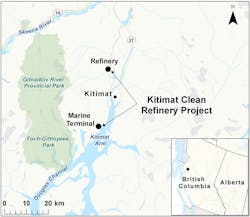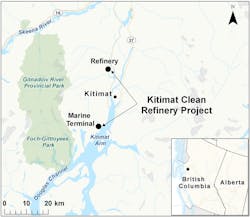Canada launches EIS for Kitimat Clean refinery project
The Canadian Environmental Assessment Agency (CEAA) has concluded a public comment period on guidelines for its preparation of a federal environmental impact statement (EIS) for Kitimat Clean Ltd.’s long-planned Kitimat Clean Refinery Project (KCRP), a proposed refinery project to be built about 13 km north of Kitimat, BC (OGJ Online, Mar. 28, 2013).
The public comment period, which invited public input on which aspects of the environment could be affected by KCRP and what should be examined during the federal environmental assessment of the project, closed on Aug. 12, CEAA said.
CEAA will consider all comments received to help determine final guidelines Kitimat Clean will use in its preparation of an EIS for the project, the agency said.
The public comment period, which began in July, follows CEAA’s June 30 decision that the project required a federal environmental assessment, CEAA said.
According to documents released in May, Kitimat Clean would build and subsequently decommission the following KCRP components upon conclusion of the project’s 50-year lifespan:
• A grassroots refinery capable of processing 400,000 b/d of pure bitumen from Alberta oil sands to produce 460,000 b/d of finished fuels. The refinery will have two 200,000-b/d processing trains equipped to produce diesel, ultralow-sulfur diesel (ULSD), gasoline, and jet fuel mostly for export to destinations in Asia Pacific. The complex also would produce propane and butane products for domestic and export markets.
• A bitumen-receiving facility, including a rail yard and bitumen offloading site. The rail yard will include storage for up to four unit trains that each contain up to 120 railcars to be delivered to yard via the Canadian National Railway (CNR) mainline. The rail unloading rack will consist of four tracks to enable simultaneous unloading of up to 240 railcars.
• A tank farm containing 54 tanks of various capacity, ranging in size from 265,000 bbl/tank to 450,000 bbl/tank for aboveground storage of bitumen, feedstock, processed hydrocarbons, and intermediate products.
• A 23-km fuel-delivery pipeline corridor consisting of three 18-in. pipelines in a 45-m wide right-of-way to transport processed fuel products to the marine terminal site.
• A marine terminal facility for loading refined products on very large crude carrier (VLCC) tankers for export. Alongside a single-tanker berth equipped to load fuel onto VLCCs, the marine terminal will also include a material offloading facility (MOF) as well as a utility berth with installations for accommodating the harbor tugs and utility work boats.
At a proposed cost of $22 billion, KCRP would be able to produce the following:
• 320,000 b/d of diesel and jet fuels, of which 50,000 b/d will be ULSD.
• 119,000 b/d of gasoline.
• 11,000 b/d of butane.
• 9,000 b/d of propane.
Slated to come on stream in 2024 pending preliminary project timelines and all necessary regulatory approvals, KPCR would be decommissioned over a 5-year period during 2073-78, Kitimat Clean said.
Contact Robert Brelsford at [email protected].

